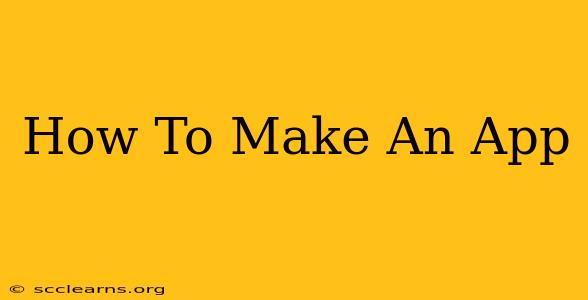So, you want to make an app? That's fantastic! The app market is booming, and with the right approach, you can create something amazing. This guide will walk you through the process, from initial ideation to publishing your app on app stores.
1. Ideation and Planning: Laying the Foundation for Your App
Before diving into code, you need a solid plan. This stage is crucial for success.
1.1 Finding Your App Idea: What Problem Will You Solve?
What problem are you trying to solve with your app? This is the most important question. The best apps address a genuine need or improve existing solutions. Brainstorm ideas that:
- Solve a problem: Is there a daily task that could be simplified with an app?
- Fill a gap in the market: Is there a niche that's currently underserved?
- Offer unique functionality: Can you bring something new and innovative to the table?
Don't be afraid to research existing apps – analyze their strengths and weaknesses to find opportunities for improvement.
1.2 Market Research: Understanding Your Target Audience
Who is your target audience? Understanding your users is paramount. Consider:
- Demographics: Age, gender, location, income, etc.
- Interests: Hobbies, lifestyle, preferences.
- Needs: What are their pain points? How will your app address them?
This research will inform your app's design, features, and marketing strategy.
1.3 Defining App Features and Functionality: What Will Your App Do?
Once you have your idea and target audience, define your app's core features. Focus on essential functionality; you can always add more features later. Create a detailed list of features, prioritizing those that directly address your users' needs.
1.4 Choosing a Platform: iOS, Android, or Both?
Will your app be available on iOS (iPhone, iPad), Android (most smartphones and tablets), or both? Each platform has its own development environment and requirements. Starting with one platform can be less overwhelming, allowing you to focus on perfecting your app before expanding.
2. Development: Bringing Your App to Life
This is where the coding begins!
2.1 Choosing a Development Approach: Native, Hybrid, or Cross-Platform?
- Native Development: Building separate apps for iOS and Android using platform-specific languages (Swift/Objective-C for iOS, Java/Kotlin for Android). Offers the best performance and access to device features but requires more development time and resources.
- Hybrid Development: Using frameworks like React Native, Ionic, or Flutter to build apps that run on multiple platforms from a single codebase. Offers faster development but might compromise performance compared to native apps.
- Cross-Platform Development: Similar to hybrid, but with different tools and approaches. Xamarin is a popular example.
Your choice will depend on your budget, development skills, and performance requirements.
2.2 Learning to Code or Hiring Developers: Skillset Considerations
Do you have programming experience? If not, you'll need to learn to code or hire a developer. Many resources are available for learning to code, including online courses and tutorials. Hiring a developer can be more expensive but saves time and ensures professional-quality code.
2.3 Design and User Interface (UI): Creating an Engaging Experience
Your app's UI/UX is crucial for user engagement. Aim for a clean, intuitive design that's easy to navigate. Consider using design tools like Figma or Adobe XD to create wireframes and prototypes before starting coding.
2.4 Testing and Debugging: Ensuring Quality and Performance
Thorough testing is essential. Identify and fix bugs before releasing your app to the public. Use testing methods such as unit testing, integration testing, and user acceptance testing.
3. Deployment and Launch: Getting Your App into the World
3.1 App Store Submission: iOS App Store and Google Play Store
Prepare your app store listing, including screenshots, descriptions, and keywords. Follow the app store guidelines carefully to ensure a smooth submission process.
3.2 Marketing and Promotion: Getting Users to Download Your App
Once your app is live, start marketing it. This might involve social media marketing, app store optimization (ASO), and advertising.
Conclusion: The Journey of App Development
Creating an app is a challenging but rewarding journey. With careful planning, diligent development, and effective marketing, you can successfully launch your app and reach your target audience. Remember to stay flexible, adapt to feedback, and continually improve your app based on user input. Good luck!

